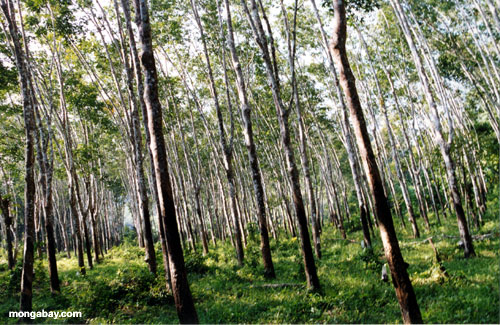Bioengineered forests coming soon? Biotech increasingly used in forestry says FAO
FAO Release

Research and applications of biotechnology in forestry are advancing rapidly says a release from the FOOD AND AGRICULTURE ORGANIZATION OF THE UNITED NATIONS (FAO).
13 July 2005, Rome – Research and applications of biotechnology in forestry are advancing rapidly, FAO said today.
A significant majority of forest biotechnology activities, around 70 percent, is taking place in developed countries, according to a new global study of biotechnology in forestry conducted by FAO, with the United States, France and Canada being the most active players. India and China are the most active of the developing countries and countries in transition.
While forest biotechnology activities have spread to at least 140 tree genera, the great majority of activities (around 60 percent) has been focused on only six (Pinus, Eucalyptus, Picea, Populus, Quercus and Acacia). Of the over 2700 biotechnology activities reported in the world over the past 10 years, genetic modification accounts for around 19 percent only.
Overall, genetic modification activities in forestry are taking place in at least 35 countries, with the vast majority apparently restricted to the laboratory, with some supporting field trials, FAO said.
Worldwide, more than 210 field trials of genetically modified (GM) trees are currently under way in 16 countries; most of the trials are being conducted in the United States and are restricted largely to Populus, Pinus, Liquidambar and Eucalyptus. Only China has reported the commercial release of GM trees: around 1.4 million plants on 300-500 hectares in 2002.
|
Weighing the benefits and risks
“Genetic modification is not intrinsically good or bad,” said Pierre Sigaud, a forest genetic resources expert at FAO. “A regulatory framework to govern research and application of genetically modified forest trees on a case-by-case basis is essential. The issue goes beyond the country level, since pollen flow and seed dispersal do not take account of national boundaries, and since wood is a global commodity,” he added.
The potential traits of interest for GM trees are increased wood production, improved wood quality and resistance to insects, diseases and herbicides. In addition, production and processing costs of wood or chips could be reduced, as well as financial and environmental costs for pulping.
But deploying GM trees is not without risks, FAO warned. Transgene instability, plantation failure, poor wood quality, development of tolerance to the modified trait by insects or disease organisms and the escape of modified genes into natural ecosystems are potential risk factors.
“Given that genetic modification in trees is already entering the commercial phase with GM Populus in China, it is very important that environmental risk assessment studies are conducted with protocols and methodologies agreed upon at national and international levels. It is also important that the results of such research are made widely available,” the study stated.
|
“The economic value of forest products in global trade is far less than that of agricultural products, and the economic rationale for employing biotechnology in forestry has not yet been clearly demonstrated,” Sigaud said. “It is not possible yet to reach conclusions on the potential impacts of genetically modified forests because of the lack of reliable information.”
“Since some 95 percent of the world’s forests are natural or semi-natural, plantation of genetically modified trees is likely to remain relatively limited,” Sigaud added.
This is a modified FAO Release. The original version is available here.
Contact:
Maria Kruse
Information Officer, FAO
maria.kruse AT fao.org
(+39) 06 570 56524
(+39) 34 814 16590 (mobile)